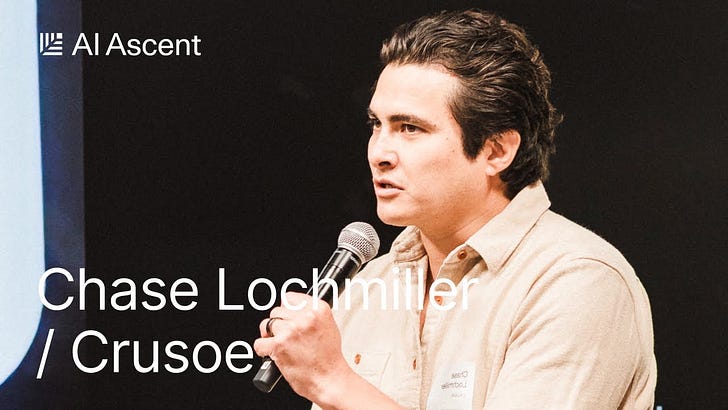The Data Center is the New Unit of Compute: Crusoe CEO Chase Lochmiller
Chase reveals how Crusoe is constructing massive AI data centers in record time to power the next generation of AI.
Post methodology: Dust custom assistant @AIAscentEssay using Claude 3.7 with system prompt: Please take the supplied transcript text and write a substack-style post about the key themes in the talk at AI Ascent 2025. Style notes: After the initial mention of a person, use their first name for all subsequent mentions; Do not use a first person POV in the posts. Light editing and reformatting for the Substack editor.In this conversation with Sequoia partner David Cahn, Chase Lochmiller, founder of Crusoe, offered a rare glimpse into the industrial backbone powering the AI revolution. While much of the discussion about AI focuses on models and algorithms, Chase illuminated the physical infrastructure making it all possible—the modern factories of intelligence.
From Flare Gas to AI Factories
Crusoe, a seven-year-old startup that began by placing computing containers on oil fields to utilize flare gas, has evolved into a powerhouse building massive AI data centers. As Chase puts it, "We're currently working on about two gigawatts of capacity currently under construction. We have about 20GW in the pipeline."
To put this in perspective, Northern Virginia—long considered the center of the world for data centers—has about 4.5GW of total capacity after decades of development. A single startup is now building infrastructure that rivals entire regions traditionally associated with computing power.
The Energy Imperative
The scale of energy required for AI is transforming both the energy and data center landscapes. Chase explains that utilities have been "such a sleepy industry for such a long period of time," with total generation capacity remaining relatively flat as efficiency gains offset demand growth. AI has introduced a "step function change in demand," forcing a fundamental rethinking of energy infrastructure.
This challenge has pushed Crusoe toward vertical integration. When faced with utility constraints, they've taken matters into their own hands: "If we can't get the power from the utility, can we build a power plant?" This approach extends to negotiating deals with small modular reactor companies to accelerate nuclear power as a critical component for future data centers.
Related: Steel, Servers and Power: What it Takes to Win the Next Phase of AI
Accelerating Infrastructure Development
One of Crusoe's competitive advantages is speed. When traditional suppliers quoted 100 weeks for essential electrical components, Chase's team established their own manufacturing facility, reducing delivery time to 22 weeks. This vertical integration and focus on acceleration has allowed them to complete massive data center projects in record time.
"Our first phase of what we're doing in Abilene, we're hitting 300 days. Our second phase, we're actually just over 200 days," Chase explains. This dramatically outpaces traditional timelines of 3-5 years for comparable facilities.
The Data Center is the New Computer
Perhaps the most profound insight from Chase's talk is his framing of modern AI infrastructure: "The data center is the new unit of compute... that's really what the AI factory is—the data center scale computer."
This represents a fundamental shift in computing architecture. Where traditional data centers might have featured racks drawing 2-4 kilowatts of power, NVIDIA's latest technology pushes this to 600 kilowatts per rack—orders of magnitude more dense. This density necessitates completely different cooling approaches, with Chase describing modern facilities as resembling "the water works" with massive pipes moving water throughout to cool the chips directly.
The scale is staggering. In Abilene, Texas, Crusoe has 5,000 people working daily on their site—in a town of just 120,000 residents. The project includes eight separate buildings designed to function as a single coherent computing cluster, connected by 44-inch conduits between network cores.
Thinking Like a Mountaineer
Behind this industrial revolution is a unique company culture. Chase, who has climbed five of the Seven Summits, infused Crusoe with a mountaineering ethos. "When you're climbing in the mountains, you have to have a plan A... But you also have to plan for things to go wrong," he explains.
This philosophy of resilience and planning for chaos has enabled the company to thrive through multiple market cycles and transformations, positioning them at the center of AI's industrial revolution.



